
工房レストラン wakuden モーリ
Koubouresutoranwakudemmori ◆ 工房レストラン wakuden MORI
3.58
Kyotango
「Japanese Cuisine」
--
--
Opening hours: 10:00-18:00(L.O.17:30) Open Sundays
Rest time: Tuesdays Business hours and holidays are subject to change, so please check with the store before visiting.
京都府京丹後市久美浜町谷764 和久傳の森
Photos
(20)








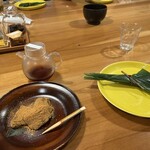





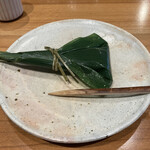





Details
Reservation Info
can be reserved
Children
child-friendly
Payment Method
Credit cards accepted
Electronic money not accepted
Private Dining Rooms
None
Smoking and Non-Smoking
No smoking at the table
Parking
having
Facilities
Stylish space
Comments
(16)
なおぉ
4.30
Rolled-up Seiko... A lotus root dessert that represents Wakyuden. It has a deep aroma delivered directly from the adjacent workshop and a delightful chewy texture. A carefully crafted dessert. Lotus root mochi... Lotus root mochi sprinkled with soybean flour. It has a gooey texture that is enjoyable, especially when paired with cinnamon syrup. Both are refreshing and perfect for summer treats.


ナルハラ空
3.70
I was surprised to find a Hekkuchuan restaurant in such a hidden place. I was able to make a reservation the day before, and it was my first visit. I had the limited MORI set, which was delicious with its well-prepared meat, fish, and vegetables. The atmosphere inside the restaurant was also nice, and I would definitely want to come back when I visit my hometown. More details here⇒https://okayama-gourmet.com/17056



yuskt
4.00
I finally went to Wakuden Nomori, a place I've been wanting to visit for a while. I ordered the MORI set lunch course. It came with a generous amount of appetizers, fish dish, and meat dish. As expected from Wakuden, there were delicious seasonings provided at the table, allowing me to enjoy changing flavors. The portion was as big as a dinner, and I left feeling satisfied.


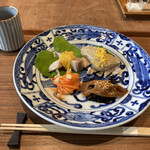

Alice.777
4.50
★Located in Kyotango City, it's a bit of a trek to get there.★The atmosphere is relaxing with a spacious garden.★TasteFreshly made Nishiko for 300 yen (tax included), and a set of Wambo and Sansho soda for 550 yen (tax included). The freshly made Nishiko is soft and bouncy, and the soda is filled with plenty of Sansho pepper. It's incredibly delicious♡




ちっち84
3.00
During a lunch break on a crab trip, I visited a restaurant and ordered the seasonal sushi using Fuji vinegar from Iio Jozo that was featured on TV recently. I ordered the meat version, the fish version, and the new warm sushi menu starting today. The meat version had roast beef, the fish version had bonito, and the warm sushi had yellowtail. Both were mild in flavor. The vinegar wasn't sour at all. You can change the flavor with various seasonings. For dessert, I had Nishiko and Jabara Sasa Tsutsumi.




るるるんるん
3.80
I visited the café at Waku Den after my visit to Ise Shrine for lunch. The menu was full of tempting options, but I decided on the fish set. The food and the rice cooked in a clay pot were delicious. And the variety of condiments at Waku Den! I tried the real sansho pepper sauce, real sansho pepper oil, and fermented ginger for the first time, and they were all super tasty. They are like doping agents for making food taste even better! By the way, you can buy these condiments at department stores in Tokyo as well. Real sansho pepper sauce is great for Japanese food, while real sansho pepper oil is perfect for meat dishes. The rice was so delicious and there was so much that I couldn't finish it all, but then they brought me "onigiri tools" - onigiri wrap and wire, etc. I can use these tools to season the rice and use up the pickles that were left over. I'll have them as a snack later. It made me happy. It was just a regular weekday and the location is in the mountains, but during lunchtime, it was about 70% full. It's popular. Ah, I'm completely satisfied. Thank you for the meal. Additional note: I wish I could have bought some condiments that are only available here. There were some with different packaging, but I wanted the ones that are exclusive to this place.


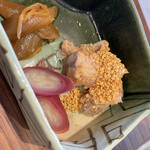

海苔1761
4.00
On the way to Kinosaki Onsen, we stopped by Yasuno Mitsuhide's art museum. After looking at the paintings, we had tea time here. I had a plum shiso soda and a lotus root sweet called Nishiko. The sweet had a truly unique texture, different from mochi, and the refined sweetness of wasanbon was not overwhelming. Please try it once.




りかとも
3.40
I have always admired Wakuden in Kyoto, but I have never been there. This year, during my crab trip, I decided to stop by for lunch before heading to the ryokan in Kumihama. Unfortunately, we arrived at the restaurant after 3 pm because my husband's errands took longer than expected. By then, they had sold out of the famous Nishiko and Mori Ohagi. So, we settled for the Mori Parfait for 800 yen and the Mulberry Soft Serve for 500 yen (excluding tax). The Mori Parfait was delicious, but I was a bit disappointed that the Mont Blanc was made with sweet potato instead of chestnut. The ambiance of the restaurant and the staff's service were excellent. I also bought some souvenirs for my friends and colleagues. I hope to have a chance to come back for lunch when I visit Kumihama again at the end of this year or next year.
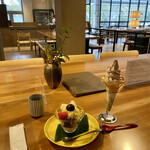



Hi!engel's
3.50
On this day, I visited the "Workshop Restaurant wakuden Mori" in Kyotango. It is quite a distance from Kabutoyama Station. The restaurant has the same atmosphere as Wakuden's "Wakuden no Mori" in Kumihama. Upon arrival, I was guided to my seat and ordered the "Forest Parfait" (880 yen) and a coffee (616 yen).
The "Forest Parfait" consisted of Mont Blanc, lotus root mochi, ice cream, seasonal fruits, and Kumihama red beans. The seasonal fruits included chestnuts, persimmons, and pears. I enjoyed the lotus root mochi, Mont Blanc, Kumihama red beans, and seasonal fruits. I would love to eat it again.
The coffee was made with pesticide-free coffee beans and was served with cinnamon syrup for a change in flavor. It was a delightful mood changer.




ファイブペンギンズ
3.80
"Wakuden" is a famous traditional Japanese restaurant in Kyoto. Many renowned chefs, such as "Gion Maruyama," "Ogata," "Kiyama," "Uonasa Ryori Nawaya," and "Ginza Fujiyama," have trained here. Established as a cooking inn in 1870 in the northern part of Kyoto Prefecture, now known as Kyotango City, Wakuden later expanded to Kyoto and grew into a representative restaurant in the city. Around 2007, they created "Wakuden no Mori" in Kyuma-hama, their founding location. With a desire to preserve the beautiful nature, they planted 30,000 trees to nurture the forest. In 2017, a lovely art museum named "Mori no Naka no Ie Yasunari Yoshitaka-kan" was established within the forest, along with the Kyuma-hama Workshop. Together, they opened the workshop restaurant and café "MORI Mori." The name of the place is derived from the Italian word for mulberry tree, reflecting the deep connection to Tanba. Despite being a remote location accessible only by car, the café is popular among locals. During my visit with two others, we enjoyed Café au Lait for 550 yen and also ordered the forest Chiffon Cake for 600 yen and a forest parfait resembling Mont Blanc for 800 yen. However, my favorite was the "Seiko" for 300 yen, a lotus root cake wrapped in bamboo leaves, which was deliciously sticky. It's a great plan to take a break at the café after exploring the art museum. As expected from Wakuden, the café provided a relaxing experience where we could enjoy both Japanese and Western treats amidst the natural scenery.




ddo
4.30
I often drive to the northern part of Kyoto, where it is not difficult to find ingredients, but there are not many places where you can truly enjoy local produce. This restaurant was able to dispel that concern for me. I had been wanting to visit for a while, and finally got the chance. I visited around 2pm on a holiday, and the place was almost full. The spacious and clean interior has a nice sense of openness. The building is surrounded by nature, making the visit enjoyable. As for the food, unfortunately the set courses were sold out, so I ordered the vegetable curry a la carte. It was amazingly delicious, with a mild spiciness, a perfect balance of broth flavor and a variety of spices. It surpasses many other specialty spice curry restaurants. The quality is very high. I would love to visit again soon and try the set courses. Thank you for the meal.
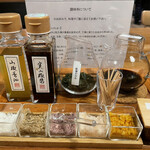

SELUNO
4.00
It's quite rural, but around 2 pm, there were surprisingly a lot of people. The founder of Wakuden is from here and created it. They have lotus root manju and West Lake plum shiso soda, as well as sake. Next to it is a museum designed by Tadao Ando, and a museum by Mitsumasa Anno. There is a vast space with trees planted. Kumiham is a nice place, isn't it?




kuroda
3.50
About a 10-minute drive from Kabutoyama Station on the Kyoto Tango Railway, located on a hill in Kumihamacho, Kyoto Tandokoro, adjacent to the Central Kitchen of Waku Den, is a restaurant. My wife and I stopped by for lunch on our way to a hotel near Kumihamawan to enjoy a slightly luxurious vacation. Waku Den operates as a Kyoto cuisine and Kaiseki restaurant, with the "Kodaiji Waku Den", as well as a slightly lower-priced "Muromachi Waku Den" and the "Kyoto Waku Den" located at Kyoto Station. They also sell bento boxes, Japanese sweets, and food products at department stores as souvenirs. Although it is now one of the famous traditional Japanese restaurants in Kyoto, its origins date back to 1870 (Meiji 3) when it opened as an inn in Mineyama, present-day Kyoto Tango City. In 1982 (Showa 57), it relocated from Mineyama to the heart of Kyoto. Since then, they have steadily expanded their business with restaurants and shops such as a tea confectionery shop called "Mushiya Shinai" and a retail store called "Omotesen". However, in Kyoto, where you cannot claim to be a long-established store in just 100 years, it is still considered a new and upcoming restaurant. In 2017, Waku Den opened "Waku Den no Mori" in Kyoto Tango City, a facility with an art museum, restaurant, and other attractions, along with a central kitchen. When you step onto the spacious grounds, the first thing you see is the "House in the Forest - Yoshitaka Anno Museum", located deep in the grove. The building, with its innovative design, stands out against the exposed concrete exterior. Inside the building, the soft watercolor paintings of landscapes from around the world, as well as the works of Yoshitaka Anno, who passed away at the end of last year (December 2020), are exhibited, along with various special exhibitions. In addition, design notes by Tadao Ando are also preserved. Further into the forest, past the well-maintained lawn, is the "Workshop Restaurant & Shop Wakuden MORI", which uses ingredients harvested from the forest and Wakuden. The interior, with large windows that give the illusion of being surrounded by the greenery of the forest and lawn, is a chic and clean space with a warm wooden feel. Near the entrance is a museum shop, followed by a shop with Wakuden products, and further inside is the restaurant, with large tables lined up. The menu consists of slightly casual dishes and desserts, and due to its location, it has a style that sets it apart from other stores. I ordered the "Tango Fish and Tango Vegetable Black Sushi" (1,900 yen), while my wife ordered the "Natural Sea Bream and Sea Bream Roe Tango Vegetable Curry" (1,600 yen). Each dish was served without much wait. The "Tango Fish and Tango Vegetable Black Sushi" was served in a vessel shaped like a split bamboo tube, with black sushi mixed with various vegetables and topped with tuna sashimi. The slightly blackish vinegar rice had a strong acidity but no sharpness typical of black vinegar. The vegetables, presumably from Tango, retained their texture and freshness. The fish, which was tuna at this time of year, was it medium fatty tuna? It had a sweetness of fat, indicating its high quality. This black sushi is a specialty of Waku Den, and in a traditional Japanese restaurant, it would use a refined sea bream marinated in kelp, but this one has a slightly wild finish. The miso soup also had plenty of ingredients, and it had a pleasant aroma of burdock. Sprinkle the dried wakame on the table, and it will add an even richer flavor. The "Natural Sea Bream and Sea Bream Roe Tango Vegetable Curry" (1,600 yen) was a creamy curry made with natural sea bream and coconut. Adding the sweet miso paste enhanced the rich flavor. On the table were dried wakame, sansho soy sauce, sansho oil, and various salts, allowing for flavor variations by adding a little to each dish. The sansho oil also goes well with the Thai-style curry.




2りんだー
4.00
I enjoyed visiting the Mitsumasa Anno Museum and had a big meal at the famous restaurant, Wakuden, located on the same premises as the museum. Originally from Kyoto Tango City, Wakuden is a casual yet elegant restaurant with excellent service. I ordered the pesticide-free Koshihikari rice with eel cooked in a pot, as well as the Shirasu Tamadome Donburi (rice bowl with whitebait). The eel cooked in a pot was quite filling, with fluffy eel and a beautiful presentation of egg, sansho leaves, and peas. The quality of the restaurant shines through even during lunch. The taste was, of course, delicious. The Shirasu Tamadome Donburi had a simple appearance but the presence of whitebait and the fluffy egg were delightful. Mixing in ginger and drizzling the mountain pepper oil on top made it even more delicious. The mountain pepper oil, made with amazing mountain pepper, was so tasty that I bought some to take home. The side dishes and miso soup were also delicious. I could feel the attention to detail in the dishes and utensils, and I am grateful to have such a good restaurant in the local area where I can enjoy the taste of a traditional Japanese restaurant in a more casual setting. I bought the Nishiko Sansho oil as a souvenir and I look forward to visiting again to try different seasonal dishes.




クラシタブリスケ
3.40
I stopped by after seeing Mitsumasa Anno's paintings. We didn't have a meal as we were going to have Matsuba crab in Kumihama at night, so we just used the cafe. I had the forest manju (bamboo shoot) & coffee, my companion had the Nishiko & coffee, and my son ordered the mulberry soft serve ice cream. The manju had a strong bamboo shoot flavor, with sweet bamboo shoot stew mixed in the red bean paste inside. It was delicious, but a bit confusing. It tasted better when I added mountain pepper oil. The Nishiko and mulberry soft serve ice cream were also delicious, especially the mulberry soft serve which had a unique flavor. The coffee was average. They suggested adding cinnamon syrup, which changed the taste completely. When I visit such places, I often think it's quite expensive. The coffee, sweets, and desserts are priced like in the city. I also looked at the meal menu, and it's quite pricey. It has a nice atmosphere and may be using high-quality ingredients, but it's expensive. It seems like a place where people from Osaka or Kobe, from the city, come to have a meal at city prices while on a trip. Since I didn't have a meal, I can't say much, but I look forward to trying the food next time. It must be delicious. Excited! ☺




Yuki-table
3.50
Second visit. This time, I went during snack time on a weekday, so the store was empty. The staff were friendly and the food was decently tasty, but... I felt like it was a bit pricey. After being shown how they make the West Lake Roll, I tried it and it was indeed very delicious.




Email Login